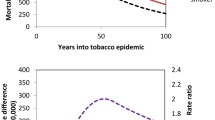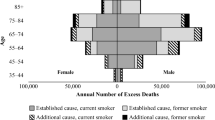Abstract
Although cigarette smoking has been extensively researched, surprising little knowledge has been produced by demographers using demographic perspectives and techniques. Thus, this paper contributes to the literature by extending a demographic framework to an important behavior for mortality research: cigarette smoking. In earlier works, the authors used nationally-representative data to show that cause of death patterns varied by smoking status and that multiple causes of death characterized smokers moreso than non-smokers. The present work extends previous analysis by estimating smoking status mortality differentials by underlying and multiple causes of death and by age and sex. Data from the 1986 National Mortality Followback Survey are related to data from the 1985 and 1987 National Health Interview Survey supplements to assess the smoking-related mortality differentials. We find that cigarette smoking is associated with higher mortality for all population categories studied, that the smoking mortality differentials vary across the different smoking status categories and by demographic group, and that the mortality differentials vary according to whether underlying cause or multiple cause patterns of death are examined. Moreover, the multiple cause analysis highlights otherwise obscured smoking-mortality relations and points to the importance of respiratory diseases and cancers other than lung cancer for cigarette smoking research.
Similar content being viewed by others
References
Benjamin, B. (1982). Smoking and mortality, pp. 433–447, in: S. Preston (ed.), Biological and social aspects of mortality and the length of life. Liege, Belgium: Ordina Editions.
Centers for Disease Control (1989). Smoking Tobacco and Health: A Fact Book. Rockville, Maryland: US Department of Health and Human Services, Publication No.898397.
Centers for Disease Control (1993). Cigarette smoking attributable mortality and years of potential life lost – United States 1990, Morbidity and Mortality Weekly Report42(33): 645–649.
Elders, J., Perry, C., Briksen, M. & Giovino, G. (1994). The report of the Surgeon General: Preventing tobacco use among young people, American Journal of Public Health84(4): 543–548.
Ernster,V. (1993). Women and smoking, American Journal of Public Health83(9): 1202–1204.
Freind, K., Belanger, A., D'Agostino, R. & Kannel, W. (1993). The health risks of smoking: The Framingham study: 34 years of followup, Annual Epidemiology3: 417–424.
Kleinman, J. (1976). Infant mortality, Statistical Notes for Health Planners2: 1–12.
Kolonel, L., Hirohata, T. & Nomura, A. (1977). Adequacy of survey data from substitute respondents, American Journal of Epidemiology106: 476–484.
Lopez, A. (1990). Who dies of what? A comparative analysis of mortality conditions in developed countries around 1987, World Health Statistical Quarterly43: 105–114.
Manton, K. & Stallard, E. (1984). Recent Trends in Mortality Analysis. Orlando, FL: Academic Press.
Marshall, J., Priore, R. & Haughey, B. (1980). Spouse-subject interviews and reliability of diet studies, American Journal of Epidemiology112: 675–683.
Metropolitan Life (1990). Deaths from chronic obstructive pulmonary disease in the United States, 1987, Statistical Bulletin71(3): 20–26.
Metzner, H., Lamphiear, D., Thompson, F., Oh, M. & Hawthorn, V. (1989). Comparison of surrogate and subject reports of dietary practices, smoking habits and weight among married couples in the Tecumseh diet methodology study, Journal of Clinical Epidemiology42: 367–375.
Mosley, W. Henry & Cowley, Peter. (1991). The challenge of world health, Population Bulletin46(4): 1–39.
Nam, C. (1990). Mortality differentials from a multiple-cause-of-death perspective, in: J. Vallin, S. D'souza & A. Palloni (eds.), Measurement and analysis of mortality: Approaches.Oxford: Clarendon Press.
Nam, C. & Rogers, R. (1996). Sociodemography of smoking and adult mortality. Final Report on National Institute on Aging Grant Number 5R01AG10113, Charles B. Nam & Richard G. Rogers, Co-Principal Investigators, 26 November 1996.
Nam, C., Eberstein, I., Deeb, L. & Terrie, E. (1989). Infant mortality by cause: A comparison of underlying and multiple cause designations, European Journal of Population5: 45–70.
Nam, C., Hummer, R. & Rogers, R. (1994). Underlying and multiple causes of death related to smoking, Population Research and Policy Review13: 305–325.
Nam, C., Rogers, R. & Hummer, R. (1996). Impact of future cigarette smoking scenarios on mortality of the adult population in the US, 2000–2050, Social Biology43: 155–168.
National Center for Health Statistics (1986). National Health Interview Survey, 1985. Health promotion and disease supplement. Public Use Data Tape and Documentation. Hyattsville, MD: Public Health Service.
National Center for Health Statistics (1988a). National Mortality Followback Survey, 1986. Public Use Data Tape and Documentation. Hyattsville, MD: Public Health Service.
National Center for Health Statistics (1988b). National Health Interview Survey, 1987. Cancer risk factor supplement, epidemiology study. Public Use Data Tape and Documentation. Hyattsville, MD: Public Health Service.
National Center for Health Statistics (1990). Vital Statistics of the United States, 1986, Vol. II. Mortality, Part A. Hyattsville, MD: Public Health Service.
Pappas, G., Queen, S., Hadden, W. & Fisher, G. (1993). The increasing disparity in mortality between socioeconomic groups in the United States, 1960 and 1986, New England of Medicine329:103–109.
Peto, R., Lopez, A., Boreham, J., Thun, M. & Health, C. (1995). Mortality from Smoking in Developed Countries, 1950–2000: Indirect Estimates from National Statistics. Oxford University Press.
Ravenholt, R. T. (1984). Addiction mortality in the United States, 1980: Tobacco, alcohol, and other substances, Population and Development Review10(4): 697–724.
Ravenholt, R. T. (1985). Tobacco's impact on twentieth-century US mortality patterns, American Journal of Preventive Medicine1(4): 4–17.
Ravenholt, R. T. (1990). Tobacco's global death march, Population and Development Review16(2): 213–240.
Retherford, R. (1975). The Changing Sex Differential in Mortality. Westport, CT: Greenwood Press.
Rimm, E., Manson, J., Stampfer, M., Colditz, G., Willett, W., Rosner, B., Hennekens, C. & Speizer, F. (1993). Cigarette smoking and the rise of diabetes in women, American Journal of Public Health83(2): 211–214.
Rogers, R. (1992). Living and dying in the USA: Sociodemographic determinants of death among blacks and whites, Demography29: 287–303.
Rogers, R. (1995). Sociodemographic characteristics of long-lived and healthy individuals, Population and Development Review21(1): 33–58.
Rogers, R. & Powell-Griner, E. (1991). Life expectancies of cigarette smokers and nonsmokers in the US, Social Science and Medicine32(10): 1151–1159.
Rogers, R., Nam, C. & Hummer, R. (1994). Activity limitation and cigarette smoking in the United States: Implications for health expectancies, pp. 337–344 in C. Mathers, J. McCallum & J. Robine (eds.), Advances in Health Expectancies: Proceedings of the 7th Meeting of the International Network onHealth Expectancy (REVES). Canberra, Australia: Australian Institute of Health and Welfare.
Rogers, R., Nam, C. & Hummer, R. (1995). Demographic and social links to cigarette smoking, Social Biology42(1–2): 1–21.
Rogot, E. & Murray, J. (1980). Smoking and causes of death among US veterans: 16 years of observation, Public Health Reports95: 213–222.
Rogot, E. & Reed, D. (1975). The validity of data from next of kin in studies of mortality among migrants, International Journal of Epidemiology4: 51–54.
Rosenberg, H., Chevarley, F., Powell-Griner, E., Kochanek, K. & Feinleib, M. (1991). Causes of death among the elderly: Information from the death certificate, in Proceedings of the 1988 International Symposium of Data on Aging. National Center for Health Statistics: Vital and Health Statistics, Series 5, No. 6.
Schoenborn, C. & Benson, V. (1988). Relationships between smoking and other unhealthy habits: United States, 1985, Advance Data154. Hyattsville, MD: NCHS.
Schoenborn, C. & Horm, J. (1993). Negative moods as correlates of smoking and heavier drinking: Implications for health promotion, Advance Data from Vital and Health Statistics236: 1–16.
Shryock, H., Siegel, J. & Associates (condensed by E. Stockwell) (1976). The Methods and Materials of Demography. Orlando, FL: Academic Press.
Sterling, T., Rosenbatim, W. & Weinkam, J. (1993). Risk attribution and tobacco-related deaths, American Journal of Epidemiology138(2): 128–139.
Thun, M., Day-Lally, C., Calle, E., Flanders, W. & Heath, C. Jr. (1995), Excess mortality among cigarette smokers: Changes in a 20year interval, American Journal of Public Health85: 1223–1230.
US Department of Health and Human Services (1989). International Classification of Diseases, 9th Revision. DHHS No. (PHS) 891260. Washington, DC: Public Health Service.
US Department of Health and Human Services (1990). The Health Benefits of Smoking Cessation: A Report of the Surgeon General. DHHS No. 908416. Washington, DC: Public Health Service.
Waldron, I. (1986). The contribution of smoking to sex differences in mortality, Public Health Reports101:163–173.
Weinkam, J., Rosenbaum, W. & Sterling, T. (1992). Computation of relative risk based on simultaneous surveys: An alternative to cohort and case-control studies, American Journal Epidemiology136(6): 722–729.
Author information
Authors and Affiliations
Rights and permissions
About this article
Cite this article
Hummer, R.a., Nam, C.B. & Rogers, R.G. Adult mortality differentials associated with cigarette smoking in the USA. Population Research and Policy Review 17, 285–304 (1998). https://doi.org/10.1023/A:1005955127544
Issue Date:
DOI: https://doi.org/10.1023/A:1005955127544




